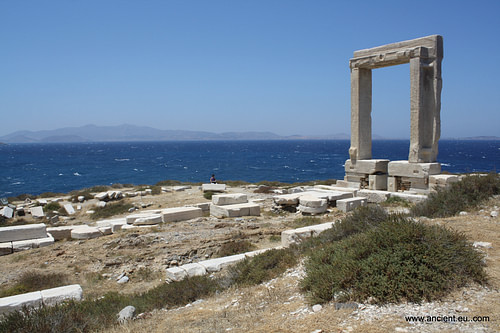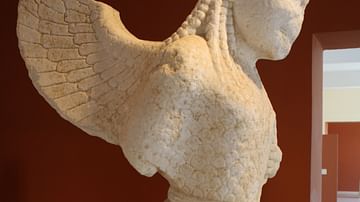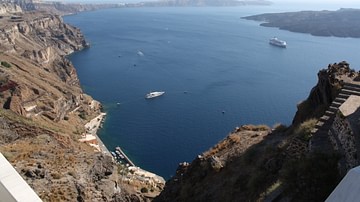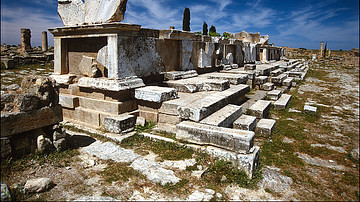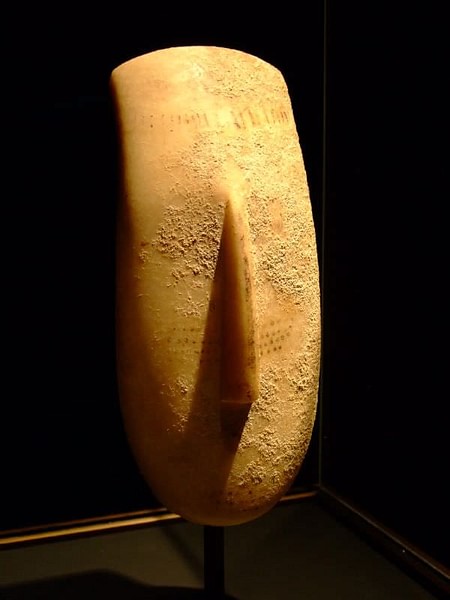
The Cyclades are a group of islands in the southern Aegean situated between the Greek mainland and Turkey. The name was coined in the Archaic period as the islands form an approximate circle (kyklos) around the central and most sacred island (at that time) of Delos. The islands had a distinctive culture in the early and middle Bronze Age and regained regional importance during the Archaic and Classical periods.
The Early Bronze Age Cyclades
The Cyclades are made of more than two hundred small islands with the most important being Naxos, Melos, Paros, Thera, Siphnos, Ios, Kea, Andros, Tenos and Mykonos. The islands display evidence of settlement from as early as 5000 BCE, most probably by voyagers from Asia Minor. One of the islands most significant raw materials was obsidian (or volcanic glass) which was used for cutting and was exported throughout the Aegean. Melos was particularly rich in this valuable commodity. In the early Bronze Age lead, copper and marble were also exported. These natural resources led to a certain prosperity which lasted throughout the Bronze Age and which may be divided into three distinct phases: Early, Middle and Late Cycladic. Precise dates for these periods are much disputed and in order to place the islands in a wider geographical context this text will adopt the broader definitions of Early, Middle and Late Bronze Age as seen across the Aegean.
The Early Bronze Age (c. 3000-2200 BCE) saw the establishment of small fishing and rural communities across the archipelago. Buildings often display stone foundations on top of which would have been unbaked clay (pisé) superstructures. The most common food crops were barley and wheat with some evidence of olive and vine cultivation. Livestock consisted of sheep, goats, cattle, pigs, and deer. Fish was also an important food source, particularly tuna and perch. Finds of spindle whorls are evidence of weaving craft and pottery finds are abundant, usually of dark vessels with decoration by incisions or white paint designs. Marble was also used to produce vessels and shapes include bowls, beakers, jars, sauceboats and frying pans. These are similar to contemporary pottery on the mainland and Anatolia and suggest cultural ties. Indeed, handled cups of this period may well be of Anatolian origin. Tools were made from bone, stone, shell and obsidian and include axes of emery. Stone graves built from marble slabs and used for multiple burials and fortifications on Syros and Andros are in both cases the first examples of their kind in the Aegean. Clay sealings suggest some sort of administrative apparatus and the minor arts are best represented by jewellery in silver and copper and by the production of small marble figurines. These highly stylised sculptures of human figures are amongst the most distinctive art objects produced throughout the Bronze Age Aegean. Early examples resemble violins but are in fact representations of a squatting female. Later examples are standing figures with arms crossed and minimalistic faces where only the nose is evidenced. Traces of paint on some surviving examples suggest that the figures were brightly painted.
Middle & Late Bronze Age Cyclades
The Middle Bronze Age (c. 2200-1700 BCE) saw an increase in the size and sophistication of settlements with a more regular town plan achieved. Populations seem also to have become concentrated in larger urban areas. Buildings are also larger and more sophisticated and fortifications become a more common feature of towns. Joining the dark burnished style of pottery is Cycladic White pottery - vessels with a matt wash and decorated with abstract motifs and geometric, floral and spiral designs. Common forms include beaked jugs and shallow bowls. There is also a marked increase in pottery imports from Minoan Crete and the mainland and a continuation in the production of marble figurines, some now being life-size.
In the Late Bronze Age (c. 1700-1000 BCE) the culture of the islands becomes less distinctive and more heavily influenced by Minoan Crete and then from around 1400 BCE by the Mycenaean civilization of mainland Greece. For example, although pottery is still locally produced it increasingly displays elements of Minoan design: sea, animal and plant life realistically depicted in flowing, vibrant forms. There is also a significant increase in the import of Minoan pottery. In particular on Thera, surviving frescoes and architecture (lustral basins and columned rooms) are remarkably similar to those on contemporary Crete. Minoan weight measurements and examples of Linear A script have also been found on the islands. Whether this proximity in art reflects any political or military domination by the Minoans in the Cyclades is, however, uncertain.
Sometime between 1650 and 1550 BCE the volcanic crater of Thera exploded in a cataclysmic eruption completely covering in ash the large town of Akrotiri on the island and creating a destructive tidal wave nine metres high which affected sites across the Aegean. The eruption was the largest witnessed in recorded history and had been preceded by earthquakes of at least 7 on the Richter scale. Such destructive forces must surely have severely affected the civilizations of the Bronze Age Aegean but exactly to what degree is much disputed amongst scholars. Even an approximate date of the event is not yet agreed upon. Ice-core and carbon-dating carried out in the early 2000s CE suggests an earlier than previously thought date for the eruption posing awkward questions for established regional timeframes. What is certain is that the eruption perfectly preserved the town of Akrotiri, giving us an invaluable glimpse of Bronze Age life at that time.
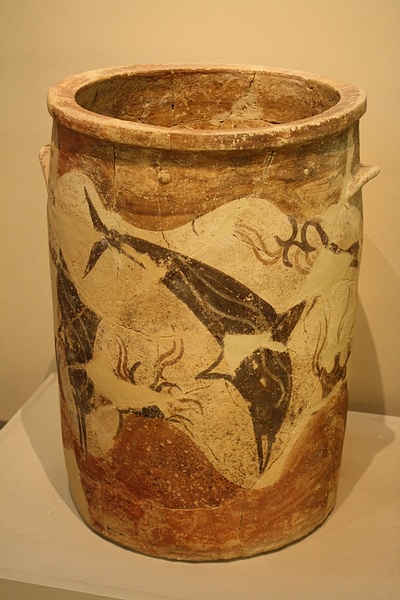
From around 1400 BCE the Cyclades reflect the rise of the Mycenaean civilization as the dominant culture in the Aegean both in a marked increase in imports of Mycenaean pottery and through architectural features in palaces, particularly at Phylakopi on Melos. The distinctive large tholos tombs of the Mycenaeans are also found on Mykonos, Tenos and Naxos. From 1250 BCE, as in other areas of the Aegean, Mycenaean influence wanes, there is an increase in fortifications of settlements and finally from around 1100 BCE there is evidence of settlement destruction and abandonment.
Archaic & Classical Cyclades
The Cyclades returned to some degree of regional importance in the Archaic and Classical periods, particularly the city-states on the islands of Delos and Naxos. Delos was the site of an important sanctuary to Apollo from 700 BCE, indeed, the god and his sister Artemis were born on the island in Greek mythology. Naxos had important temples in honour of Apollo, Demeter and Dionysos, with the latter being born on the island according to mythology. Dionysos was also believed to have married Ariadne on Delos and the occasion was celebrated annually in the Archaic period. In the 8th century BCE Naxos founded the first Greek colony in Sicily and in the 6th century BCE the tyrant Lygdamis, aided by his ally Peisistratus, the tyrant of Athens, led a period of prosperity for Naxos. It was during this period that the temple of Apollo was built and the Dionysia festival - famous throughout the Greek world - was first established to honour Dionysos, god of wine. From the 6th century BCE the island of Paros began to export its fine white Parian marble so valued by Greek sculptors and architects.
During the turbulent 5th century BCE when Persia attempted to conquer Greece, several of the Cycladic islands rose to prominence. Naxos was attacked in 499 BCE and again in 490 BCE by the Persian forces of Darius and the island was a significant member of the united Greek forces which fought and defeated the Persians at the celebrated battles of Salamis in 480 BCE and Plataea in 479 BCE. From 478 BCE many islands were members of the Athenian led Delian League which had its treasury on the island of Delos (until its removal to Athens in 454 BCE) which was established to better repel Persian aggression. The League was not altogether harmonious though as rebellions from Naxos in 469/8 BCE and from northern Thasos in 465 BCE display. Some members were not at all happy at the way Athens began to dominate the League but the powerful maritime state swiftly quashed such uprisings.
During the Peloponnesian War (431-404 BCE) between Athens and Sparta and their respective allies, the Cyclades were generally on the Athenian side but there were instances of dissent, perhaps most famously on the island of Melos which had actively supported the Spartans and so was attacked and defeated by Athenian forces from 417 to 415 BCE. All of the island's males were killed and all women and children sold into slavery. When the Second Athenian League was established from 377 to 355 BCE, the islands once again sided with Athens in defence against Sparta but also this time, episodes of rebellion occurred, notably on Keos in 363 BCE.
Hellenistic Cyclades
In Hellenistic times (from the 2nd century BCE) the islands came under the rule of the Ptolemies of Egypt and in Roman times the islands came once again under Athenian rule (166 BCE) but they, nevertheless, enjoyed once more a period of prosperity thanks to their trading position in the Aegean. This period came to a dramatic end though with the attack on Delos in 88 BCE by Mithridates and the subsequent setting up of a pirate base in the archipelago by Athenodoros in 69 BCE. Indeed, the islands' reputation as a safe haven for pirates would last right through to medieval times and beyond. Finally, the last vestiges of the Greek civilization on the islands disappeared when many of the Greek temples were converted into Christian basilica in the 5th and 6th centuries CE. However, from the mid-20th century CE, the world would once again remember the Cyclades' contribution to western European civilization when archaeological excavations revealed the important sites of Akrotiri (on Thera - now Santorini), Ayia Irini (Kea), Phylakopi (Melos), Kastri (Syros), Kavos (Keros), Skarkos (Ios), Paroikia (Paros) and Strophilas (Andros). These sites are still being excavated today and they continue to contribute invaluable insights into life in the ancient Aegean.

